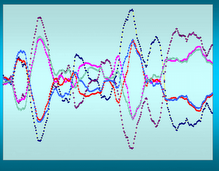For the past 10 or 12 years of so, or for about as long as I’ve been working with Marlyn’s Curve I’ve noted that the market cycle is roughly 20 business days. And as time has progressed out of the 90’s into the 2K’s the cycle has seemed to become more pronounced and deliberate. I have come to understand that this is being caused by the influx of 401K money that feeds into the stock market about every 20 business cycle days or so.
This isn’t a problem today but if we take the baby boom as beginning in 1948 and we add 60 years to that, around the year 2008 the leading edge of the boom will be able to begin extracting their money with no penalty or added taxation. Needless to say this is the generation that has made a science of extracting every penny of the equity in their homes so that they could buy more junk – do you really think they are going to leave their 401K’s intact?
So if we believe that what goes up must come down this will start looking like a balloon with the air being let out of it. As soon as the earliest bunch starts extracting funds the later comers are going to start noticing some shocks to their system. Especially those folks who have been contributing to a 401K all of their working life - all of a sudden the market is going to go backwards on them and in a hurry.
As a result it is possible that they will do two things – first, move all of their funds to money market accounts (within the 401K system there is always a “safe” cash capability) as quickly as they can (much the same way I did in 2000); and, second, start counting the days until they too can withdraw their bucks without penalty. There is no third option because, you see, there are no other pension options left in this country. Folks have to continue contributing to their own pensions because that’s all there is.
The rapid withdrawal of funds from the 401K stock accounts will cause the stock market to sink to depression levels in a short time. I know this because we already have a case to study and that is the depression of 2000 – 2003. The tech bust caused many funds to see major outflows including those funds that had nothing to do with the tech boom in the first place. But, and this is a huge but – the 401K money kept flowing into the plan administrators. The problem is it didn’t go into stocks - for the most part it went into relatively safe, money market savings accounts.
Here’s proof – this is the Dow Industrial Average from 1990 to yesterday. Note how the market depressed from 2000 to 2003. (By the way – that’s a rounding top you are looking at – it works on a lot of different time scales – this is monthly). Also note that the INDU volume increased massively through the 90’s fell during the depression and is once more on the rise.

Here is Marlyn’s Curve portion of the boxed portion of the chart above. Notice that there was huge volatility during the Bear market and that the volatility has been damped out of the market since about March ’03. Point A on both charts are approximately equivalent.

Finally while volume is an indicator it is not the be all and end all. Here is the COMPQ over the last 10 years. See how the volume has never declined after the tech bust. I think that’s because most trading is done in NASDAQ while most investing is done in the large caps. And there is a difference between trading and investing.

Unfortunately our Government has no plan to deal with any of this – except for “privatizing” Social Security. By “privatizing” SocSec they mandate that people’s paychecks must flow into the stock market and they might prevent a major, wealth destroying meltdown – for awhile at least. As always who do you think is going to be left holding the bag?

No comments:
Post a Comment